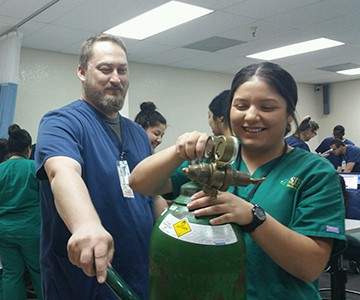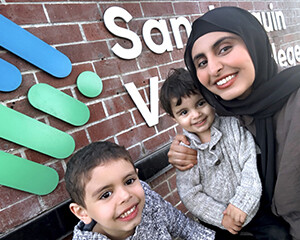Visalia Respiratory Therapy and Medical Assisting students share learning experience
 Students-teaching-students is an innovative and interesting way to learn for Visalia campus Respiratory Therapy and Medical Assisting students.
Students-teaching-students is an innovative and interesting way to learn for Visalia campus Respiratory Therapy and Medical Assisting students.
Two or three times a year, groups of Medical Assisting students spend about an hour with Respiratory Therapy students in their lab learning about procedures and equipment that they may use in their medical careers. Students provided instruction on performing pulmonary function measurements and tests, as well as using various oxygen tanks and the devices used to administer oxygen.
“This is Respiratory Therapy students’ specialty, administering pulmonary function tests, using peak flow meters and spirometers,” says Sujana De Almeida, Medical Assisting program instructor. “It is a wonderful opportunity for the Respiratory Therapy students to share their knowledge and skills with the other students.”
Each group of about 16 Medical Assisting students visited four stations set up in the lab where they learned and practiced specific treatments, using specialized equipment. 14 Respiratory Therapy students, under supervision from their instructors, explained and demonstrated procedures and then instructed Medical Assisting students toward their own proficiency.
“Medical Assisting students learned how to do a spirometry test for lung disease, usually for COPD (Chronic Obstructive Pulmonary Disease),” says Christine Foster, Respiratory Therapy instructor. “The Medical Assisting students performed the spirometry on each other, under the direction of the Respiratory Therapy students.”
This is not just an opportunity for Medical Assisting students to learn; Respiratory Therapy students also benefited from this lab exercise. “The Medical Assisting students’ questions strengthen the Respiratory Therapists in their communication skills when they verbalize what they are doing and why,” says Foster. “Both groups learn how to communicate medical information to their patients.”
After the training exercise, Mrs. De Almeida collected reflection cards from her Medical Assisting students so that she might measure information retention, teaching value and student appreciation. Medical Assisting student Anastasia Parrish-Huereca wrote: “The students in the Respiratory Therapy lab were very informational and friendly. I appreciated what they did for our class today.”
Medical Assisting students moved from station to station learning and participating in a variety of respiratory and pulmonary procedures while asking lots of questions and increasing their knowledge and scope of experience.
Respiratory Therapy students got to be on the other end of instruction for a change. “This gave Respiratory Therapy students a great opportunity to learn their content on a different level by actually teaching it, and they liked when the Medical Assisting students asked good questions,” says Foster. “The Medical Assisting students loved this hands-on opportunity and appreciated the instruction from fellow students.”
Respiratory Therapy is a specialized field that many Medical Assisting graduates may find themselves entering should their medical office employer provide those services, or if they work with a pulmonologist (lung specialist).
“It was a great experience for the Medical Assisting students because they were engaged, they were involved and they were excited to learn from the Respiratory Therapy students,” says Mrs. De Almeida.
Both Respiratory Therapy and Medical Assisting program students look forward to and benefit from this very successful exchange.
You might also like
More stories about
Request Information
All fields using an asterik (*) are required.


